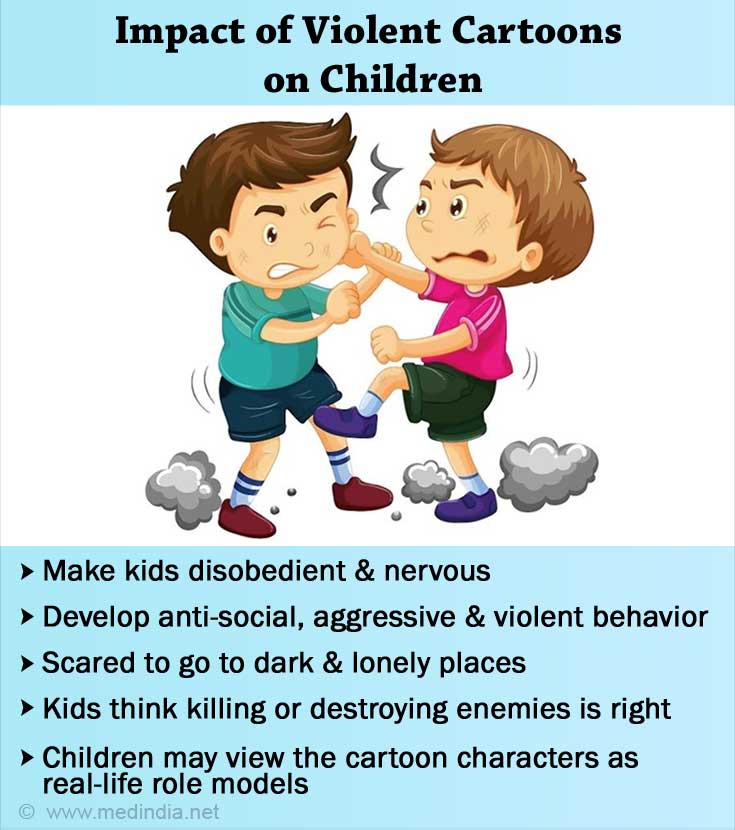- Media use in childhood: Evidence-based recommendations for caregivers - (https://www.apa.org/pi/families/resources/newsletter/2019/05/media-use-childhood)
- Parenting Children in the Age of Screens - (https://www.pewresearch.org/internet/2020/07/28/parenting-children-in-the-age-of-screens/)
- Negative Impacts of Cartoons - (https://novakdjokovicfoundation.org/negative-impacts-of-cartoons/)
- Impact of Violent Cartoons on the Behaviour of Children: A Case Study of South Punjab - (https://publishing.globalcsrc.org/ojs/index.php/jbsee/article/view/1212)
- How Media Use Affects Your Child - (https://kidshealth.org/en/parents/tv-affects-child.html)
- The influence of violent TV cartoons watched by school children in Turkey - (https://www.scielo.br/j/ape/a/qPBYGp8xynP9xRncKGTZBFg/?lang=en)
- The Influence of Cartoons on Children's Socialization - (https://enlightngo.org/language/en/post/7795)
- Five ways cartoons are good for children's development - (https://themediaonline.co.za/2018/08/five-ways-cartoons-are-good-for-childrens-development/)
- Cartoon's Effect in Changing Children Mental Response and Behavior - (https://www.scirp.org/html/17-1760575_59815.htm)
- Impact of Cartoon Programs on Children's Language and Behavior - (https://www.researchgate.net/publication/323523698_Impact_of_Cartoon_Programs_on_Children's_Language_and_Behavior)
- Impact of media use on children and youth - (https://www.ncbi.nlm.nih.gov/pmc/articles/PMC2792691/)
- Internet Gaming - (https://www.psychiatry.org/patients-families/internet-gaming#:~:text=The%20DSM%2D5%20notes%20that,of%20social%20media%20or%20smartphones.)
- Expanding the Definition of Addiction: DSM-5 vs. ICD-11 - (https://www.ncbi.nlm.nih.gov/pmc/articles/PMC5328289/)
- Social media addiction: Its impact, mediation, and intervention - (https://cyberpsychology.eu/article/view/11562/10373)
- Analyzing Political Cartoons - (https://www.ncpedia.org/anchor/analyzing-political-cartoons)
What is the Role of Media in Children’s Lives?
Media has become increasingly influential in the lives of every individual, and children are no exception. With parents using different forms of media to keep their children occupied when busy, and coaxing them to eat, young children these days are constantly bombarded with different forms of media.
One study found that 89% of parents of children aged 5 to 11 years reported their child using YouTube. It may come as a surprise that 81% of 3-4 year olds and 57% of children under the age of 2 years are also consumers of YouTube.
| Age Group | Screen Time Per Day |
| 2 years | 1 hour |
| 2 – 8 years | 2 hours |
| 8 – 12 years | 4 – 6 hours |
| Above 12 years | 7-9 hours |
Children are exposed to different forms of media from cartoons to the cinema to news to advertisements. Through these sources, they also come across violent or sexual content that affect them. One area of concern is the impact of violent cartoons.
What is the Impact of Violent Cartoons?
One study suggests that an average child is exposed to 2 lakh violent behaviors on TV by the age of 18. Many of these could be from unrealistic cartoons that appear harmless. Several popular cartoon shows portray violence in a comical or acceptable manner. Let us understand how violent cartoons can affect children:
- Cartoons normalize violence and make it seem common and acceptable
- Repetitive, unpunished, and realistic violence is likely to be mimicked by children
- Violent cartoons can lead to disobedient, nervous, and aggressive tendencies
- Cartoons can desensitize children to others sorrow, pain, and violence occurring around them
- Children may begin to view the cartoon characters as real life role models and the aggression shown can be internalized
- 78% of children felt scared to go to dark or lonely places after watching horror cartoon shows
- 71% of children think that killing or destroying enemies is the right thing to do
- Violent cartoons can lead to antisocial behavior
- Boys are more likely to imitate violent cartoons than girls

What are the Positive & Negative Effects of Watching Cartoons?
Cartoons can help aid children’s brain development. The positive effects of cartoons include:
- Learning about the world
- Improving vocabulary and language acquisition
- Understanding the rules in society
- Learning skills such as teamwork
- Cognitive development - Developing thinking and imagination, problem solving, and creativity
- Imitating positive characteristics of healthy role models
- Source of stress relief, and enjoyment
- Prosocial behavior such as helping the elderly and underprivileged
- Developing moral values such as sharing and being fair
- Learning about dangers in the environment
The negative effects of watching cartoons include:
- Learning inappropriate violent and sexual behaviors
- Lack of empathy
- Disobedient behavior
- Using swear words
- Obesity, vision, and nutrition-related health issues due to continuous screen time, and reduced physical activity levels
- Inappropriate role models
- Cartoon addiction
How Else Can Media Affect Children?
Media also comprises content on tablets, smartphones, videogames, and advertisements. Children who spend more than 4 hours daily on a screen are more likely to become obese. Violent video games also increase aggressive behavior.

Media may also lead to smoking, drinking, and other habits. It can encourage racial, gender, and other stereotypes. Excessive media consumption may also impair attentional capacity, sleep, and socio-emotional development. It can affect academic performance.
Children are likely to form misrepresented ideas about sexual activity, and the risks involved. It can also lead to inappropriate sexual behavior. Younger children up to the age of 8 years are likely to be influenced by the countless advertisements promoting unhealthy, fatty, sugary foods, and other unnecessary products.
Music videos can also influence children with their increasing violent, sexual, and substance related content. The Internet also has inappropriate content such as pornography which misinforms children about sexual activity, what is acceptable and what is unacceptable.
In addition to this, addiction related to media is increasing at a significant rate. Behavioral addictions such as internet addiction, social media addiction, and internet gaming disorder can be seen in children and teens.
What can Parents do to Ensure Healthy Media Consumption?
It is the role of parents and educational institutions to ensure that children’s media consumption and perception are healthy. Parents should monitor the content of cartoons and other media that young children watch. They should help children critically evaluate and analyze the content they see to form an informed opinion.
The parent can ask the child questions such as, “Do you think that is healthy?” They can also help children differentiate between reality and fantasy. Therefore a child will be able to differentiate between violence and its consequences in a cartoon versus in real life.

Parents should arrive at a decision on the amount of time (less than 1-2 hours per day) and the type of content the child can watch. If some cartoons are prohibited, the reason must be explained to the child in a way he/she can understand.
Appropriate educational cartoons are also available. Shows should be watched in a common area in the house and the devices must be accessible to the parents. Audio CDs and informative educational channels can be employed instead of cartoons.
The use of cartoons as a diversion when parents are busy needs to be avoided. Other activities such as puzzles, playing outdoors, or learning a new skill can be encouraged. Children must be praised, and reinforced for following the decided guidelines or showing healthy patterns of consumption and perception.





